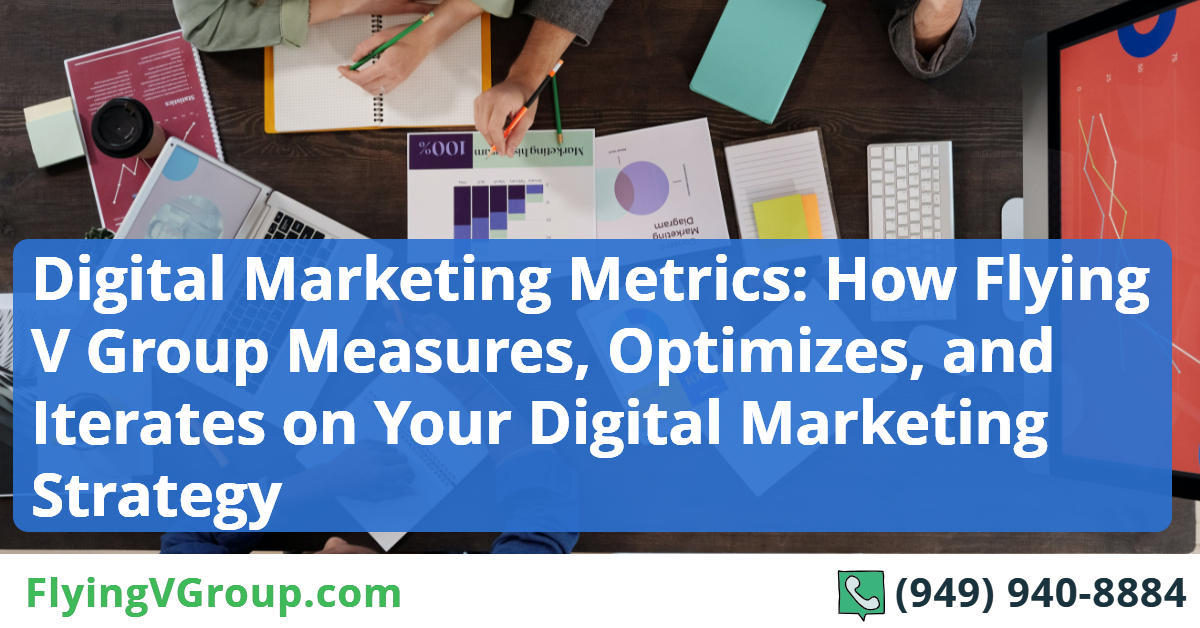If you don’t measure it, it is as good as not doing it. In simple words, that is one of our core philosophies at Flying V group. This intense focus on numbers is a critical asset for any marketing team and any campaign you run. A comprehensive marketing strategy involves multiple variables, and also deals with several audience personas, preferences, and other parameters. This means that consistently tracking the numbers is the only foolproof way to understand how it’s performing, and also to learn and to optimize your strategy.
This approach keeps us focused on some important numbers, or metrics as we call them. Metrics are the dials look at to make sure that your strategy is working, but there is a very important thing to remember here. Metrics can be lead metrics or lag metrics.
Simply put, lead metrics are those that can be measured while the campaign is running, and gives us an indication of how the campaign is performing. Lag metrics on the other hand let us complete the picture. They allow us to look at the strategy as a whole and understand the results that emerge. Both kinds of metrics are equally important for an effective strategy.
A good strategy most definitely involves multiple goals—some major goals, and some minor ones too. Taking a look at previously defined metrics against benchmarks and targets would be the most objective way of defining what success looks like. It also helps to gather more insights about your audience in general.
Here, we are going to go into some detail to understand FVG’s approach to digital marketing metrics and how we measure, optimize and iterate your digital marketing strategy using these metrics.
What are Metrics and How are They Different from KPIs?
Simply put, metrics are some measurable parameters that you identify that give you a benchmark against which to assess your strategy. These numbers indicate the overall effectiveness of a process—the digital marketing strategy in this case. On the other hand, KPIs are closely related to business goals and are more strategic. They show how effective the strategy was in meeting overall business goals.
To use an example, cost per acquisition is a metric in most cases, while revenue from marketing leads or renewal rate is a KPI as it directly impacts the business outcome from your department or the organization as a whole. KPIs are always aligned towards the bigger picture and overall business impact, while metrics deal with the more detailed aspects of the strategy.
What are the Main Metrics We Look At at FVG?
There are a variety of metrics that need to be tracked to determine the success of any strategy. Most of these metrics come from the primary and secondary goals of the campaign being planned. An easy way to segregate them would be to use the concept of lead and lag metrics we discussed above.
Lead metrics help us keep track of indicators that correlate with the final campaign success. Let’s take the metric website visitors for example. A good campaign drives a good amount of traffic to the website. If this number does not compare to the goals, you can assume that the strategy is not performing as planned, and something needs to be fixed. It is a bit like looking at the indicators on the dashboard of a car—they tell you if everything is running all right.
Lag metrics, on the other hand, give you a sense of the final campaign output. These metrics can only be tracked over a longer period, and you would also need enough data to accurately assess the overall performance.
Both lead and lag metrics are important for the overall success of the campaign. These metrics tell you if the strategy is optimized or if it is ineffective. After all, when it comes to marketing, how you get there is as important as the goals themselves.
What are the Key Lead Metrics We Look at?
We consider several lead metrics while executing a strategy. It is important to map these to the right goals and, over time, establish clear correlations to the outcome. Here are some of the top lead metrics we consider at FVG
Unique Visitors
This is a very important metric. The number of visitors coming to the website tells us how well the strategy is working. As the marketing outreach will span several channels, it is also important to have a sense of where these visitors are coming from. This gives us an idea of what is working and what is not, which can be fixed to make sure that the campaign is optimized.
Time on Site and Pages Per Visit
Having a sense of the time people are spending on your site will give great insights into understanding how well the content is working. If people are spending more time on average, it means that they are finding the content that is on the site more valuable.
Tracking the number of pages people are visiting per session is also very useful. Visiting more than one page shows more intent, and also engagement.
Forms Filled Out
Forms filled out are a great leading indicator. The best way to establish interest in your product/service is having someone fill out a contact form asking for more information or to try out a product. It is a product of the quality of content and the process. Having more leads at the top of the funnel is a good way to ensure a good outcome at the end of the campaign.
Open and Click-through Rates
For email campaigns, these are the two most important metrics to track. Emails are a powerful tool in the process and perhaps the most engaged channel too. Tracking the open rates and click rates tells us how well the emails are working and also whether the content is resonating with the target.
What are the Key Lag Metrics We Look at?
We get a proper look at these metrics, which are more closely aligned to KPIs than lead metrics, only at the end of the campaign. Here are some of the top metrics we track.
Actual Conversion Rate
The actual conversion rate tells us how many actual conversions happened from the campaign to the total number of people engaged. This helps us understand how well the campaign worked in terms of outcome and business value-added. Having a healthy conversion rate also reassures you that it is a good idea to invest in the process more over time.
Sales Cycle Length
In most of the campaigns we run, engaging with the prospects who are in the funnel is very important to us. There is a lot that content can do in this area. Having a sense of the total sales cycle length gives you a sense of how well customers move along the funnel and become customers.
Resource Signups/Purchases
The total number of signups or sales that the campaign created is an important number to track. Ultimately, the objective of any campaign is to generate revenue. Having a system to track leads by source will help you greatly here as you can establish which customer came from where and it will also help you recreate this journey.
Conclusion
Leading and lagging metrics are inextricably linked to one another. There is a good reason for this too. Over time, as the campaign works, it helps us to establish benchmarks for metrics and determine what are good numbers to ensure a good outcome from the campaign.
Tracking lead metrics is a very important part of the optimization strategy as it runs. There are many levers to pull and looking at the lead metrics can tell you which ones to pull. Lag metrics are equally important because they give you a bigger picture and help you to understand how well the strategy worked in terms of actual business outcome.
Rated the best digital marketing agency in LA, Flying V Group can help you deliver measurable results in terms of your digital marketing metrics.
SHARE THIS POST
Thank you so much for reading Paid Ads 101: How to Use Your Spend Budget Wisely . We really appreciate it! If you have any questions about our article, or can suggest any other topics you think we should explore, feel free to let us know.
Be sure to sign-up for our newsletter to receive monthly emails on all of the latest trends and happenings in the digital marketing space. You will also receive our FREE E-Book with the Amazing Marketing Tools for Powerful Business Growth. Sign-up below!
Also, if you received some value out of this article, please share with your friends or colleagues, or leave a comment/question below. We really appreciate you reading our blog and every share/comment means the world to us and allows us to continue producing valuable tools to help you grow your business!






0 Comments